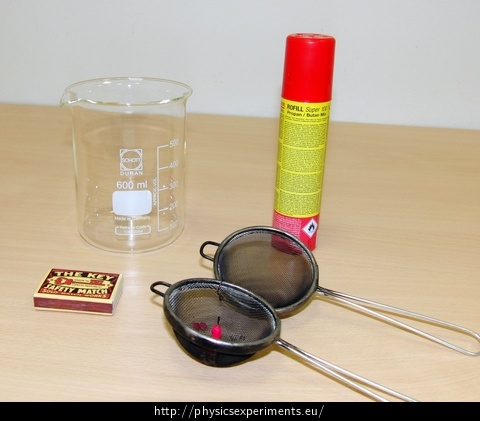Davy Safety Lamp
Experiment number : 1947
Goal of experiment
In this experiment we will demonstrate the very important role of thermal conductivity of metals in a safety lamp constructed first in 1815 by Sir Humphry Davy, an English experimenter.
Theory
At the beginning of the 19th century, black coal mining was on the rise in the United Kingdom. With it came the increasing number of deaths caused by explosions of methane, the most prominent part in mine gases which form a highly explosive substance when combined with air. The cause of these explosions were usually the miners themselves, or more precisely their oil lamps with an open flame; that is why there was an ever increasing demand for a safe lamp to protect the lives of miners.
The English physicist and chemist Humphry Davy (1778-1829) created the first so called safety lamp on demand of the miners – he simply put the flame into a metal cage. Because the metal intensively transferred heat from the flame, this construction prevented the temperature around the flame to exceed the ignition point of the explosive substance. The presence of methane then did not lead to an explosion, but only to an increase of the flame, which clearly signalled to the miners that the place is not safe and must be immediately evacuated.
In our experiment we will demonstrate both the Davy lamp and a lamp with an open flame. We will use a candle instead of an oil lamp; the pocket of methane will be simulated by a can of butane (lighter gas). Two metal kitchen sieves will suffice as our metal cage.
Tools (Fig. 1)
Two identical metal kitchen sieves, lighter gas (usually butane), cake candle, matches, transparent glass beaker, pliers, skewer
Procedure
First part of the experiment: Model of a lamp with an open flame
We spray a small amount of lighter gas into the beaker.
The lamp with an open flame will be represented by a cake candle which we bring in pliers near to the top edge of the beaker (see video in the part Sample result); the gas lights up very fast.
Second part of the experiment: Model of the Davy safety lamp
We fix the candle to the bottom of one of the sieves so that it does not fall over.
We again spray a small amount of gas into the beaker.
We light the candle and cover it with the second sieve; the flame is then in some kind of metal “cage”.
We carefully insert the whole “cage” into the beaker with gas. If we do it right, the flame lights up only in the small volume between the sieves, but the flames do not spread to the rest of the beaker (again see video in part Sample result).
Sample result
Sample execution of both parts described above can be seen in the following video:
Technical notes
To successfully execute the experiment it is necessary to hold the sieves close to each other so that there is no gap between them. Any “leakage” of the metal cage can lead to igniting the gas in the beaker.
Common cake candles are usually too high to fit between two sieves, so they usually must be shortened. The flame should in any case stay inside the cage.
Butane, which we use to model the mine gas, has more than twice the density of air and therefore stays on the bottom of the beaker. We do not need to work hastily in fear of it leaving the beaker quickly.
Safety warning: We must take into account that hot wax can drop from the candle during the experiment. When demonstrating the lamp with an open flame, we always insert the candle into the beaker using pliers, never with our bare hands! Working with butane necessitates increased care!
Pedagogical notes
It is essentially possible to skip the first part of the experiment and show only the Davy lamp; however, then the role of thermal conductivity as the main physical principle we want to demonstrate becomes less apparent.
Students sometimes explain the fact that in case of the Davy lamp the gas lights up only inside the cage by saying that most of the gas already left the beaker and so there is nothing left to burn. In that case we can try to light the remaining gas in the beaker with a skewer after removing the Davy lamp.
We can discuss with the students why, even with the Davy lamp, miners had to leave places with increased occurrence of methane. As was stated above, the presence of methane increased the flame of the lamp, which led to more intense heating – there was the risk that the metal construction heats up to the ignition point of mine gas. (The more sophisticated models of the lamp were even able to determine the concentration of methane based on the height of the flame.)
Davy lamp as an identifier of mine gases
Perfecting the Davy lamp allowed it to be used not only as a light source, but also as a sensitive identifier of dangerous mine gases. The lamp was equipped with a scale that allowed measuring the height of the flame inside. If the flame rose over a given limit, it meant there was an increased amount of methane in the air; on the other hand, decrease of the flame signalled a higher concentration of carbon monoxide. Both cases meant danger for the miners and led to a quick evacuation of the mine.








